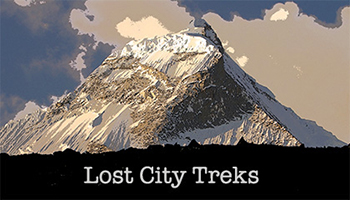
The Cordillera Blanca
The Cordillera Blanca (The White Range) is located in the department of Ancash, which lies to the northeast of Lima. Treks in the Blanca are usually based out of the city of Huaraz (see below). The Cordillera Blanca is well known as the highest tropical mountain range in the world with 27 summits over 6000 m. The tallest mountain in Peru (Huascaran 6,768 m) is also located here. Other notable mountains are Alpamayo (5,947 m), which was voted the "most beautiful mountain in the world" by somebody at some point- from the north is admittedly about as symmetrical as a mountain can be, and Artesonraju (6,025 m), which is clearly the inspiration for the Paramount Pictures logo. Treks in the Cordillera Blanca are driest in June/July/August, but April/May and September/October can be good too.
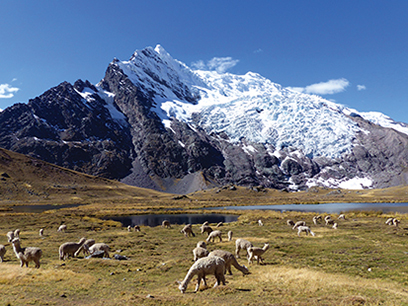
The Vilcanota Range
The Vilcanota Range lies roughly north of Cusco and its biggest mountain, Ausangate (6,384 m), is the distant snow peak easily visible from high points near the city center on a clear day. The Vilcanota boasts a total of some seven summits that reach 6000 m. This is a beautiful region of open country known for its immense herds of llamas and alpacas and wild vicuñas grazing the high tundra. A total of four hundred and sixty nine glaciers have been counted in the Vilcanota. This extensive glaciation is surely due to the range's location adjacent to the Amazon basin. Treks in the Vilcanota can be done from May-October with June-July-August being driest. Treks here also have a greater average altitude than other ranges, so be prepared for cold below-freezing nights.
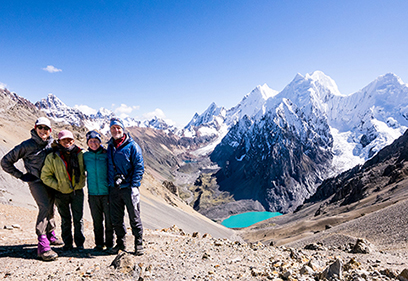
The Huayhuash
The Huayhuash is a like a little slice of the Himalayas tucked away in north-central Peru and a bit to the south of the Cordillera Blanca. Its great peaks, Yerupajá (at 6617 m the second highest mountain in Peru), Siula Grande (6344 m), Sarapo (6127 m), Jirishanca (6094 m), and Rasac (6017 m) are legendary in mountaineering circles. The region is remote and sparsely populated with varied terrain and impressive vistas of glaciers and turquoise lakes. The Huayhuash trek has had a lot of press in recent years and has gathered a reputation of being one of the world's greatest and legendary treks.
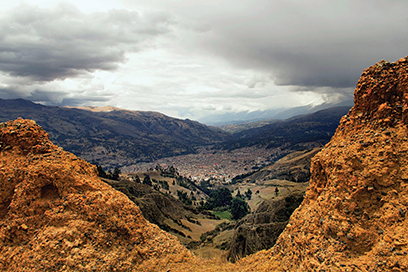
Huaraz
Huaraz is a city of more than 120,000 people located in a spectacular valley near the head of the Callejon de Huaylas. It is a modern Andean city with many restaurants, hotels, and just about anything you might have forgotten to bring with you may be found here. We use Huaraz as as our base for trips into both the Cordillera Blanca and the Huayhuash. The city itself while not particularly attractive is reasonably safe and does boast a museum with the greatest collection of pre-Spanish statues in South America. Huaraz is about an eight-hour bus ride from Lima. LC Peru also has regular flights to Huaraz. Traveling between Huaraz and Cusco is best done via Lima. There are no direct Huaraz-Cusco fights.

Cusco
Cusco needs no introduction. It is at heart a typical Andean city, but constructed around what remains of the amazing royal city of the Incas. Its great food, hotels, and nightlife are well known, and it makes a great base for the treks into the surrounding regions. Roads in the department of Cusco tend to be good, so getting around is no problem. Most people fly into Cusco from Lima and there are many flights every day.
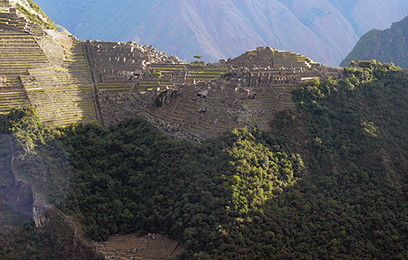
Machu Picchu
Almost everyone who visits Peru makes the pilgrimage to Machu Picchu and despite the annoyances of the crass commercialism and unavoidable crowds it really does have no equal. Its famously remote location is indeed a fair distance from Cusco. Access is limited to the train or on foot and it can be done in a day from Cusco, but that's not ideal. Some are surprised to discover that Machu Picchu is not located in the high mountains, but far below Cusco in the montane rainforest. This is still quite precipitous terrain, but jungle with gaudy tropical birds and various other exotic fauna.
